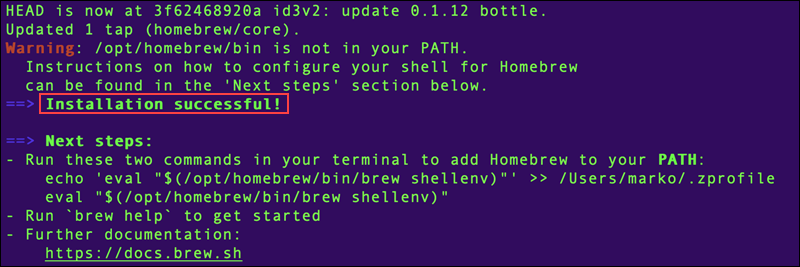

- #INSTALL HOMEBREW FOR MAC#
- #INSTALL HOMEBREW INSTALL#
- #INSTALL HOMEBREW VERIFICATION#
- #INSTALL HOMEBREW SOFTWARE#
So it's best to have an idea of what you want before searching that huge list. There are over 5,000 formulae, which is an incredible amount of software. You can see all the "formulae" that are available from Homebrew using the search command, and I use the wc command shows how many formulae there are: # -l counts the number of lines Installation happens with the brew command, which gives us access to thousands of command-line utilities, but not more complex applications.įor us nerds, the utilities that fit into "the stuff you need" category include the handy tree command that shows directory structures and pyenv, which I use to manage multiple versions of Python.
#INSTALL HOMEBREW INSTALL#
Homebrew boasts that it "installs the stuff you need that Apple (or your Linux system) didn't" install by default. $ bash homebrew_installer.sh Manage your command-line utilities with brew $ more homebrew_installer.sh # review the script until you feel comfortable If you prefer to be more cautious, you can curl the file, then run it manually after reviewing it: $ curl -fsSL -output homebrew_installer.sh This command executes the installer script provided by the Homebrew team. If you're on a Mac and don't already have Homebrew, you can install it with: $ /bin/bash -c "$(curl -fsSL )" It provides an incredibly smooth and straightforward experience for anyone familiar with the command line, and it's a good way to learn the command line if you're new to it. Homebrew fills the void as the de facto package manager for macOS (and as another option for Linux).
#INSTALL HOMEBREW FOR MAC#
There is no default package manager for Mac users, while Linux users have many options-from the familiar yum and apt to the modern choice of Flatpak. One place where the Mac operating system, macOS, has always been behind Linux is in package management.
#INSTALL HOMEBREW SOFTWARE#
Instead of pointing and clicking to manually manage my applications and utilities, I prefer to use package management software to install, update, and remove unneeded software.
#INSTALL HOMEBREW VERIFICATION#
It uses SHA256 as its package verification check.In my quest to "automate all the things," I have been on a journey to manage my Mac laptop as the code it inherently is. It’s safe as long as you understand what you are downloading. Homebrew acts like a command-line package installer. In addition, Homebrew can install its own current versions of glibc and gcc for older distributions of Linux. Homebrew does not make use of any libraries provided by your host system, except glibc and gcc if they are new enough.

To display the packages installed with the brew command, do this: $ brew list 2 shs shs 4096 Oct 4 13:17 includeĭrwxrwxr-x. 11 shs shs 4096 Oct 4 15:45 Homebrewĭrwxrwxr-x. 2 shs shs 4096 Oct 4 12:54 Frameworksĭrwxr-xr-x. 3 shs shs 4096 Oct 6 16:17 Cellarĭrwxrwxr-x. 2 shs shs 4096 Oct 4 15:30 Caskroomĭrwxrwxr-x. 3 root root 4096 Sep 30 14:51 /home/linuxbrewĭrwxrwxr-x. Your linuxbrew directories will look something like what you see below. In the command show below, a second package is installed: $ brew install hello Space is to place as eternity is to time. Trying out your installed app might look like this: $ fortune (Notice the cute little mug of brew at the bottom left.) 🍺 /home/linuxbrew/.linuxbrew/Cellar/fortune/9708: 82 files, 2.4MB => Homebrew is run entirely by unpaid volunteers. To test it out, you can install some tools with commands like these: $ brew install fortune The command will prompt you at some point to enter your password.


 0 kommentar(er)
0 kommentar(er)
